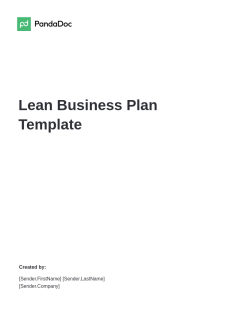If you’ve got a good idea and an entrepreneurial spirit, you’ve probably considered starting your own business at some point.
But, even if you’ve got some experience with business operations, actually bringing that idea to life is no simple task.
Traditional business plans can help, but they might be far too complicated if you’re in the early stages of business development or you aren’t intended to seek external funding to start your company.
If that’s the case, a lean business plan is probably a better answer.
In this article, we’ll talk you through the details of a lean business plan, and we’ll show you how to write in this step-by-step guide.
Ready? Let’s get to it.
Before you start your business plan
What is a lean business plan?
Lean business plans tend to be geared toward early-stage businesses that don’t need any kind of outside investment and have no intention to seek financing in order to start their business.
Lean plans are more flexible than traditional business plans. They cover much of the same information — but not all of it — and the format isn’t as strict.
However, there is a key difference to consider.

Lean Business Plan Template
Used 4995 times
Use this Lean Business Plan Template to enlist your business with the applicable agency in your jurisdiction. All of the areas are fully customizable and can be tailored to your detailed necessities.
Use this templateTraditional business plan
A traditional business plan (template here) is primarily a marketing document designed to help an entrepreneur acquire funding.
With a traditional plan, the business owner needs to prove that they’ve considered their business fully and show a potential investor (or banking agent) how they plan to invest the funds to create a successful enterprise.
Lean business plan
A lean business plan is more of a vision document. The plan format doesn’t usually include any kind of financial documentation, and it doesn’t always follow a predetermined template or format.
Instead, this plan is much shorter (often one or two pages) and is primarily designed to help new business owners get their ideas on paper and figure out how to transform them into a viable company.
It’s possible to scale a lean plan into a traditional plan if funding is required, but it’s not the main purpose of this plan.
With all that said, keep in mind that any business plan is still all about helping you make money at the end of the day.
While your lean business plan will probably be shorter than a traditional plan and all accompanying financial documentation, the decisions that you make while planning will have a direct financial impact on your business once you get started.
The key difference is that you’ll be investing (and losing) your own money — so it pays to be prudent, do your market research, and come back with a plan that maximizes your profit while minimizing costs.
Remember: A lean plan isn’t a shortcut to creating an effective business strategy or a viable company.
No matter your bottom line, if you don’t have the necessary financial resources, the company won’t be able to accomplish its goals and may not even be able to keep its doors open.
A lean plan can help you define your vision and determine the best path forward but, like all business plans, it’s only as good as the work you put into it.
Why do you need a lean plan?
Lean business plans, like other types of plans, are most useful when helping you better understand the environment surrounding your business and how your company will need to operate in order to stay competitive in the marketplace.
A lean business plan can help you determine each of the following details:
- Competitive positions, strengths, and weaknesses.
- Target audience and their incentives to buy your product.
- Uniqueness of your value proposition.
- Primary competitors in the marketplace.
- Chief revenue opportunities and cost centers.
- Timeframes around launching and getting underway.
- Resources necessary for success.
As you write your plan, you’ll need to evaluate your target marketing, including buyers and brand competitors.
You’ll need to develop strategies for how you’ll stand out, what sales channels make the most sense for your business, and how you need to talk about your products and services in order to generate strong interest from buyers.
Without this information, you risk launching your business into an unknown and unexplored market, which will open you up to massive deficits and competitive exposure as you try to adjust on the fly.
When should you write your lean business plan?
There are a few great times to write any business plan, and a lean business plan is no exception.
Keeping in mind that a lean plan is a business document, you should consider creating this plan in any of the following circumstances:
- You want to start a business and you don’t need funding.
- You’ve acquired a company and need to evaluate your market position.
- You have an existing business and need to pivot your offering to better serve your customers or developing market.
However, it’s important to note that a lean plan isn’t a static document that needs to be frozen in time.
Unlike a traditional business plan, which often serves as a snapshot of your business operations and planning, a lean plan is flexible enough to evolve quickly and can be updated with greater frequency as your business grows and customer needs evolve.
Businesses commonly discover new or related markets shortly after they first open their doors, necessitating a pivot in products and services.
Update your lean plan accordingly and share it with your leadership team, then execute a new strategy to capture the new opportunity.
Parts of a lean business plan
In this section, we’ll cover the parts of a lean business plan.
While we’ll cover each section in-depth below, one important thing to remember is that your lean plan should be focused on developing your business idea into a viable company.
To do that, you’ll need business partners, a decent understanding of your cost structure, and some insights into what successful businesses in your industry might look like.
These plans are best-fits for early-stage startups (pre-seed), solopreneurs, and similar businesses with no immediate need for funding.
If you’re planning to launch your business as part of a funding-backed enterprise, be prepared to use the information you gather as part of a lean plan into a more traditional plan when the need arises.
01. Identity
The identity section of your document covers your business details, including what your company does and how you identify with your target customers.
It’s often best to think of this as an elevator pitch for your business. Your identity statement doesn’t have to be overly complicated, but it should sum up the crux of your business in a few words.
If you find that you can’t do that when formulating your business, you might need to spend more time thinking about what you’re actually trying to do and how you can best serve your intended market.
Examples
- We provide fast and friendly commercial photography services for e-commerce businesses and online boutiques.
- I’m an end-to-end travel consultant. I create custom vacation and travel packages to help aspiring vacationers see more of the world.
- We sell high-quality, affordably priced walking and running shoes for families and amateur athletes.
02. Problem worth solving
Put simply, this section represents an existing problem that you’re getting into business to solve.
What’s driving you to start the business? Maybe you feel like a specific service doesn’t exist or you can offer better pricing or a better experience in a unique market.
Once your business enters the market, what problem will it solve?
Examples
- Commercial photography feels very “corporate,” and no company in our region offers brand-oriented imagery.
- Finding good vacation destinations off the beaten path is hard work, and it’s something that most people can’t do on their own.
- You shouldn’t have to be an expert to get good shoes.
03. Solution
If the problem (listed above) is one half of the equation, how you plan to solve it is the other half.
In this section, you’ll want to highlight your answer to that problem by pointing out how your business solves the issue.
While the details are obviously more complex than what you can list in a lean plan, this solution should encapsulate how your business stands apart from everyone else.
Examples
- Our team of imagery consultants and photographers works with marketing teams in a collaborative way to generate stunning, on-brand imagery.
- I bridge the gap between vacationers and off-beat destinations using personal travel experience and a background in travel planning to create dream vacations.
- Our shop helps individuals of all skill levels equip themselves for workouts and fitness that they’re comfortable with. We’re also a judgment-free zone.
04. Target market
In this section, you’ll want to list your ideal customers for your business. You can do this using a number or bulleted list, and it doesn’t have to be particularly complicated.
Because a lean plan isn’t as in-depth as a traditional business plan, it might be tempting to add any potential customer to this list.
Further reading: How to find your target market
However, it’s best if you take a little time and do some additional market research to ensure the customer you want exists in quantities large enough to sustain your business.
Examples
- Regional businesses with an online store.
- Young couples who want a non-traditional vacation.
- Fitness newbies who want to get into shape.
05. Competition
No matter how unique your business or idea, you’ll always have competitors.
Take a look around (both locally and online!) and see who might offer services that are similar or competitive to yours.
Keep in mind that, while pricing and cost aren’t everything, they play a large role in the marketplace.
Consider that as one factor among many while trying to assess your competition.
Examples
- Other commercial photographers.
- Corporate travel agencies.
- Big-box shoe retailers.
06. Sales сhannels
Depending on the nature of your business, your sales channels will vary.
Do you plan to sell products online-only, or are you opening a retail store for products? Do you even sell a physical product? Will services be rendered remotely or in person?
Examples
- We sell bundle packages on our website and offer custom pricing via video consultations.
- I offer custom solutions via online consult only.
- We sell shoes and accessories via our retail store. We also sell online directly through our website.
07. Marketing activities
One of the most important aspects of your business deals with how you’re planning to inform your customers about your business and the services you offer.
Raising customer awareness and generating leads is one of the most important things that a business can do, but marketing activities can also become a major cost center for the business.
Even though a lean plan is designed to help clarify the bigger picture, it’s important to do your research before you decide on your planned marketing tactics.
Examples
- Launch an image-focused marketing blog to raise awareness around advertorial pitfalls that brands often make with their images.
- Create a “been there, done that” marketing campaign using social media to demonstrate personal travel expertise and invite others to join in.
- Purchase sponsorships and connect with local runners to insert brand into existing athletic community.
08. Revenue streams
We said it before, but it bears repeating: At the end of the day, it’s all about the money. You’ll need cash flow to keep your business afloat.
In this section, you’ll want to cover how you plan to generate that revenue. What products or services do you plan to sell? What will be your flagship products?
In the example below, we’ve listed a flagship product or service for each of our imaginary businesses. However, you can list multiple products or services for your own business as bullet points in this section.
Examples
- 24-pack eCommerce image bundle.
- Customized vacation packages for couples.
- Running shoes.
09. Expenses
To keep your business running, you’ll need to invest some of your revenue back into the company to cover operating expenses.
Further reading: 12 Major Business Expenses (and How to Reduce Them)
In this section, you’ll want to highlight those primary cost centers. If you’re still in the planning process for your business, you may not have any metrics for your own operation.
In that case, doing your research can help you better determine what major expenses you’re likely to encounter as you get your business off the ground.
Examples
- Payroll (consultants, photographers, and admin).
- Marketing and advertising on social media.
- Rent for commercial space.
10. Milestones
Now that you’ve got most of the basics out of the way, you’ll need to come up with logical next steps to get your business operations underway.
To do this, you’ll create milestones to meet your business needs. While these milestones can be quite broad and may involve many subtasks, they still need to have some specificity so that you can plan for the future.
Examples
- Build and launch website by end of Q3.
- Create a destination partnership database (before launch).
- Find and secure retail store location (August 22nd).
11. Team and key roles
Some businesses can be done alone, but most are a team effort. In this section, you’ll want to list all of the key players and roles that you need in order for your business to function.
Keep in mind that, as the business owner, the expertise and knowledge of your staff are some of your most valuable assets. Depending on your niche and your specialty, replacing a key employee can be a major challenge.
While building out your list, consider what steps you’ll need to take when a key player exits your business.
Examples
- Alex: Photography Director
- Cindy: Owner & Travel Guide
- Marcy: Sales Manager
12. Partners and resources
No business can thrive on its own.
Whether you need help with your marketing strategy or you need to hand over your books to an accountant at the end of the year, you’ll need partners to help you navigate murkier waters.
In this section, list any major partners and key resources that you’ll need in order to continue operating with your competitive advantage.
Examples
- CanNik Camera Repair
- Green & Green: Accountants
- Run Free: Wholesale Running Supplies
Better business planning with PandaDoc
While writing a business plan might feel like a monumental task, it’s often the first major step when starting your business.
PandaDoc can help you do more with your business plan by offering advanced layout, formatting, and collaboration tools.
Grab a free business plan template from the template library and see the PandaDoc editor in action by signing up for a free 14-day trial.
Originally published Oct 17, 2017, updated Jun 21, 2022
Frequently asked questions
-
A detailed business plan is much longer and is typically used whenever you need financing.
When you’re creating a plan for your own use, or when you’re planning to self-fund and aren’t seeking investors, a lean plan can be the better way to get started.
That being said, you can always scale up your lean plan into a traditional business plan, if you decide that funding or additional information is needed.
None of the work that goes into your lean plan needs to be wasted if you decide that your situation demands something a little more formal somewhere down the line.
-
A business plan definitely isn’t required to open your business, especially if you aren’t seeking a loan. However, good planning can help you achieve your goals faster and with lower overall costs.
A business plan, whether you use a one-page business plan like the lean plan here or a traditional plan, forces you to formalize your idea and conduct market research that will help to further define your brand.
Often, creating a workable plan requires you to determine key metrics and ideal customer segments. Formal plans may even ask for sales forecasts or financial forecasts to help lenders better understand your projected profits.
You won’t see as much of that with a lean plan, though the numbers-driven details should definitely play a role in your regular review once the business is up and running.
-
No, and you probably won’t.
No matter how well you prepare, no business plan will ever be perfect, and you’ll always encounter some unexpected problem that no one anticipated. A business plan can help you predict some of those problems, but you won’t be able to plan for scenarios where a distributor has trouble or a new competitor opens its doors.
At some point, you’ll have to stop writing and start operating your business. Set a personal deadline to stop planning and start working.
Perfection is the enemy of good enough.
-
This depends on your plan and the objective of the plan itself.
Lean business plans like the one listed here are often created using a single page or a few pages (at most). Even if you want to follow a more traditional route, a personal plan probably shouldn’t run more than around 10 pages.
That’s different from a funded startup, which can be closer to 30 pages, once the market analysis and all financial details are accounted for. These plans venture strongly into VC and investment funding, which often necessitates higher investments and a great amount of due diligence. In these scenarios, you might also be looking at a pitch rather than a plan.
For more traditional businesses or existing businesses seeking funding from a small business loan officer, somewhere between 7 and 15 pages is probably sufficient for your needs.
-
Certainly. In fact, this is expected.
A business plan is best viewed as a living document that should grow and evolve with your company. Markets shift. Public interest goes in new directions. New competitors and business opportunities may arise.
As your business grows, you’ll need to shift your focus or pivot your business model to accommodate for those changes. Your business plan should evolve with you in order to best reflect the position that your organization needs to take in order to remain profitable.
-
Yes, although it can depend on who you’re speaking to and how you’re trying to secure funding.
If you’re trying to get a loan from a bank, a business plan is almost mandatory. A small business loan officer will evaluate the validity of your plan and may come back to you with questions before authorizing your loan.
On the other hand, a VC firm or an angel investor may expect a pitch, rather than a business plan, especially if you’re in a pre-seed round and have no cash flow or financials that they can actively evaluate. They’ll also be interested in anything else you can use to make your case, like intellectual property (patents, inventions, etc.) that make your business model unique and defensible.
In either case, your potential investors want to know that you’ve done your research and that they aren’t throwing away their investment. Even if you need to pitch, starting with a business plan can help you figure out how to address these pressing questions.
-
No.
It might be tempting to hire a consultant, strategist, or writer to help you create your business plan, but this is something you should do by yourself or with the help of your business partners.
Why? Because, as the business owner, the knowledge that you’ll gain from the research is invaluable to the long-term success of your company. It’s not something that you should outsource.
Of course, we aren’t saying that you should avoid shortcuts. Use a lean business plan template or a traditional business plan template, if that helps you kickstart your creative process. After the plan is written, you can even bring in writers, editors, and graphic designers to make it look great.
Keep in mind as well that nobody knows everything. While writing your business plan, you’ll probably spot gaps in your own knowledge in key areas of your business operations.
Surround yourself with experienced advisors and mentors that you trust so that you can fill those knowledge gaps. If you aren’t sure where to find them, resources like SCORE or the Small Business Administration (US) and similar websites can help you get started. You may also need to hire mentors and specific talent in order to succeed.
-
Most business plans follow a template or a process. Pick one you like and that makes sense for your business, then follow it.
Keep in mind that length isn’t everything when it comes to business plans.
You don’t always need a 30+ page document to get a loan from the bank, and supporting documentation around financing and past success may be just as important to lenders and investors as good planning skills.
-
No, although you’ll want to make sure that all of the basic information is covered if you choose to deviate from any standard format.
Some readers may be expecting a specific format or a document that’s styled similarly to other business plans that they’ve seen before.
The more you stray from the accepted format, the harder your plan will be to interpret, which could cause confusion and complicate the lending or investing process.
Disclaimer
PandDoc is not a law firm, or a substitute for an attorney or law firm. This page is not intended to and does not provide legal advice. Should you have legal questions on the validity of e-signatures or digital signatures and the enforceability thereof, please consult with an attorney or law firm. Use of PandaDocs services are governed by our Terms of Use and Privacy Policy.


